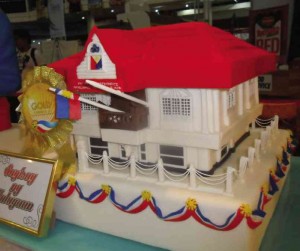
When a bomb recently exploded in Cagayan de Oro (CDO), my first thought was of our friends there. Were they safe? I had walked near the place where the explosion happened, ate at some of the restaurants in that row. A call helped to ease my mind about my friends. And it helped that I was to see them in a few weeks.
Every year for 17 years now, the culinary competition “Kumbira” is held in this capital city of Misamis Oriental. It is run by the Cagayan de Oro Hotel and Restaurant Association (Cohara). The members are proud of the fact that their project has lasted this long, and one can see that it’s because of their camaraderie— the importance they put to working together even if they are business competitors.
For years now, I have been invited to judge the competition, together with other chefs and writers. We always look forward to the event; it is work certainly, but, inevitably, it also becomes a get-together of friends.
Special event
This year was an even more special event. Eileen San Juan, competitions chair, said during the opening ceremony that none of the judges hesitated to come despite the recent violent incident, and she and her group appreciated that. However, some of the competitors, many of them from other Mindanao provinces, withdrew because no assurances could be given the parents that their children would be safe.
When we landed in CDO, the spanking-new Laguindingan airport surprised us. One of the judges said that when he saw the landscape, he mistakenly thought he had landed in Davao. The drive downtown was much longer now, but it’s also safer for planes to land at the new site; the old airport, after all, involved landing on top of a mountain.
The Limketkai Center, where the competitions have been held these past years, was not as crowded on the first day, although more people came on the second day. The presence of Tourism Secretary Ramon R. Jimenez Jr. during the opening was a sign that everything was back to normal. I do hope he keeps his promise of promoting Mindanao more aggressively as a tourist destination.
‘Being Filipino’
The entries have improved a lot, perhaps because competitors have learned a thing or two from the debriefing given after each competition, with judges telling contestants what was wrong or right about their cooking or presentation.
I was asked to judge the cake decoration, which had the theme “Being Filipino.” One group made a cake depicting Aguinaldo’s Cavite home; another devised a jacket using the design of the Philippine flag.
Another competition involved cooking and packaging cashew, one of CDO’s agricultural products. Entrepreneurship was this year’s “Kumbira” theme, which included how to brand and
sell products. Some of the seminars included talks by owners of successful enterprises in the province, such as Vjandep’s pastel, a bread resembling bonete with custard. Though Vjandep pastel originated in Camiguin, it is also manufactured in a CDO factory.
What I really enjoyed was the cooking and presentation of kakanin. The contestants showed how the delicacy could be served on a buffet table or during formal meals. The kakanin was cut for one serving, placed on decorative banana leaf or in small glasses. The better ones had contrasting textures. The one that impressed us most had dipping sauces of chocolate, coffee and a buttery syrup. My fellow judge and I enjoyed tasting each concoction—a maja, bibingka malagkit, suman, bicho.
Highlight
Of course, the highlight of the competitions was the Chef Wars for both professionals and students, which picked out those who would be sent to Manila to compete in the finals at the National Food Showdown on Sept. 20- 21 at the World Trade Center in Pasay City
The Mindanao finalists are La Vetta Restaurant and Wine Bar (professional) and Fr. Saturnino Urios University in Butuan City (student). The Visayas finalists who were picked two weeks earlier are Bacolod Academy of Culinary Arts (student) and Business Inn/Planta Hotel (professional).
Last week, it was the turn of the National Capital region and Southern Tagalog, which declared as finalists the International School for Culinary Arts and Hotel Management or ISCAHM (student) and Marriott Manila (professional). This week will have the Northern Philippines competitions in Baguio, to determine the finalists from that area.
As we left CDO, we were glad that things weren’t only back to normal, but the signs of progress were also unmistakable, such as the new airport and new hotels like Seda which was our temporary home. What has remained the same is the good food—perfect lechon, for instance, and the sinuglaw, a combination of charcoal-broiled pork and kinilaw.
Another good sign was that I was getting used to the suwa, the aromatic lime added to the mix; it had put me off the first time I smelled it because it was like eating soap. I now look for that aroma to tell me that what I’m having is authentic sinuglaw from CDO.
E-mail the author at pinoyfood04@yahoo.com